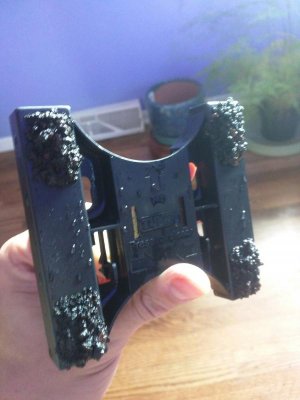JonezNReef
Member
Hello! I've been searching the forum for current info regarding people's experience using the Jaubert plenum, and I've enjoyed your posts. I was hoping you would take some time to help me with a bit of guidance. Thanks in advance!
I'm currently running a 180 gal reef tank that utilizes a 30 gal refugium and a 60 gal sump. I have built a plenum in both the refugium and the sump. The display tank utilizes live rock that I made myself (2 parts FL crushed coral, 2 parts Special Grade Reef Sand, 1 part white Portland Cement). The refugium also contains a glass bowl with approx 2" deep Miracle Mud in which I have growing 6 red mangrove seedlings. The sump has a GAC media chamber, calcium reactor, and a protein skimmer. Lighting is via Orphek Atlantik V3 pendants.
I was motivated to set up the plenum after reading Live Sand Secrets by Bob Goemans. However, I now find that the crushed coral substrate is fused together in the refugium. Interestingly, this does not seem to have occurred in the sump. The only major difference is that the sump is not lit. Have you experienced this issue? What might be the cause, and do you think it is a problem? I worry that the fused substrate might impede nutrient transfer.
I noticed in one of your posts that you mentioned having a 20 yr old setup that utilizes such a plenum, but would not construct a new tank with one. Would you elaborate as to why, and would you recommend that I remove mine?
My tank parameters are:
NO3 2ppm
PO4 undetectable using my Hanna colorimeter
dKH 8.5
calcium 415ppm
salinity 1.025
temp 24 deg C
The tank setup is relatively new; July 2016. Fish were added first; corals only since Jan 2017. I am having issues with browning and poor polyp extension with some SPS. Certain frags have succumbed to RTN. Most LPS and soft corals are fine, with the exception of a couple of chalice corals that experienced local bleaching and tissue death.
Some of my SPS are fine, but taking all of the symptoms together, including loss of 2 red collar snails and the semi-permanent retraction of a third, I feel there is something going on in the system. I am trying to troubleshoot and would like your experienced feedback concerning the system generally and the Jaubert plenum specifically. Thanks again for your time.
I wanted to do a plenum in my 180 but decided against it at the last moment but I doubt that it is your issue here. The crushed coral fuzzing together happens a bit in a lot of tank not just ones with plenums. As for your coral, your parameters seem on point and I am no expert but I am wondering if your lighting might be the issue. A lot of corals brown up when they aren't getting enough light. I am unfamiliar with your lighting and not sure what intensity they are set at and how many you are running but thats something to look into maybe. Have you had any sudden swings in ALK, PH, or Temp because those are major causes of RTN. Also have you added anything new just before it started?


